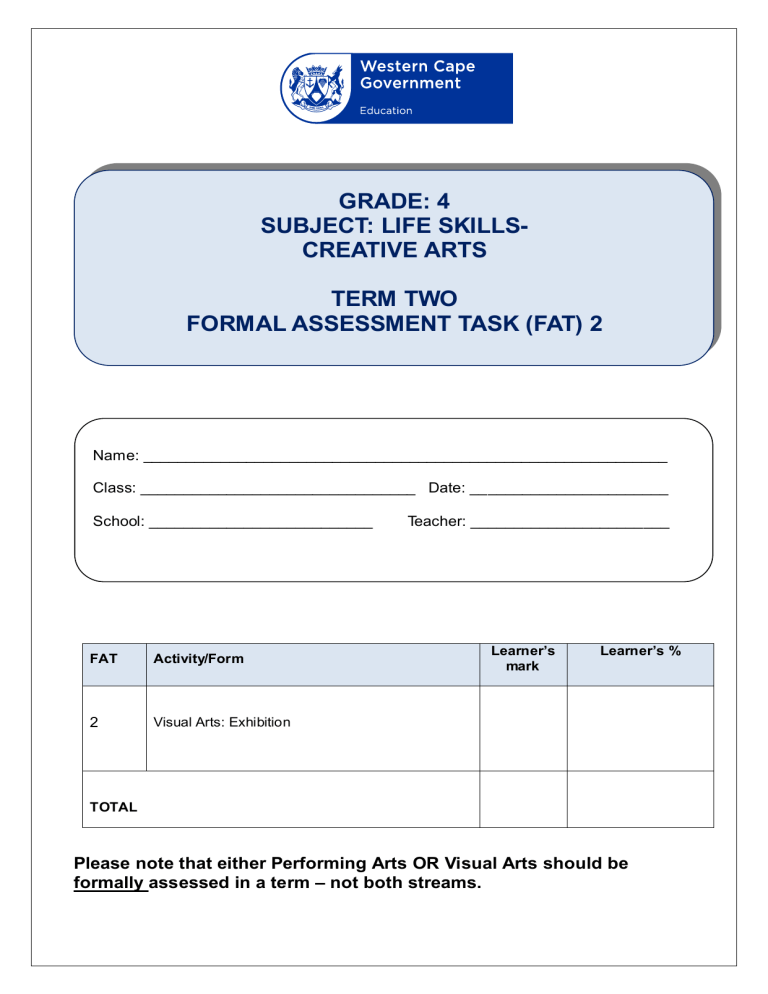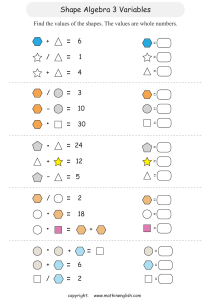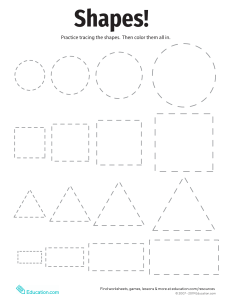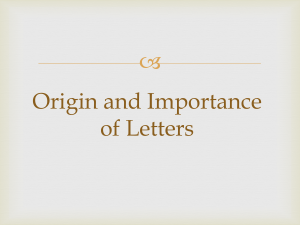
GRADE: 4 SUBJECT: LIFE SKILLSCREATIVE ARTS TERM TWO FORMAL ASSESSMENT TASK (FAT) 2 Name: _____________________________________________________________ Class: ________________________________ Date: _______________________ School: __________________________ FAT Activity/Form 2 Visual Arts: Exhibition Teacher: _______________________ Learner’s mark Learner’s % TOTAL Please note that either Performing Arts OR Visual Arts should be formally assessed in a term – not both streams. LIFE SKILLS: CREATIVE ARTS FORMAL ASSESSMENT TASK: VISUAL ARTS GRADE 4 TERM 2 NOTE TO THE TEACHER: The Formal Assessment Task has been developed as a step by step guideline to learners. The activities are to be done in class, during the second term. It is important that teachers mediate the various steps of the task with learners to ensure active, creative and critical participation by all learners. ACTIVITY 1: CREATE IN 2D & 3D, CREATIVE LETTERING AND/OR PATTERNMAKING ART MATERIAL: A3 paper, sturdy paper / cardboard, scissors, glue, pencils, black wax crayon or koki, oil pastels or wax crayons, powder paint, strong thread / ribbon, recyclable materials, natural objects, wire or wood or drinking straws for hanging, beads, sequins, anything that can be used for decoration. INSTRUCTIONS: You will be designing and creating a mobile incorporating patternmaking and the creative use of lettering. The word “mobile” means something that moves. So, a mobile in art is made up of pieces that move. GR 4: FAT LS – Creative Arts: Visual Arts: Term 2 1|P a g e In this artwork, you will use the elements of art called LINE, SHAPE/FORM and SECONDARY AND RELATED COLOURS and the design principle called BALANCE (SYMMETRICAL / ASYMMETRICAL), PROPORTION and SPATIAL AWARENESS. It is very important to notice the different types of patterns around you in your environment e.g. in nature or in architecture (OBSERVATION). You must concentrate hard and look at all the unique aspects of the different patterns you see. Discuss: With the aid of your teacher explore what you already know of the concepts of patternmaking and using lettering in a creative way. Look at all the different types of patterns and lettering you can see around you. Look at the shapes and forms. How are they shaped? Are they circular, wavy, geometric, etc? Discuss mobiles and their significance, as well as how pattern is incorporated in their design. It is important for you to visualise your design e.g. a painting is very different from a drawing. Let us practise first: First trace the lines of the different patterns in the air. Now, take a black wax crayon and on an A3 piece of paper, begin to draw different patterns and try to use lettering in different, creative ways. GR 4: FAT LS – Creative Arts: Visual Arts: Term 2 2|P a g e Try to create your own patterns and lettering, do not just repeat the basic ones that you may already know or were taught. There is no right or wrong! Just draw! Take your time and draw your patterns and creative lettering slowly and carefully. Now let us start the final artwork: Your teacher will now hand out a new sheet of sturdy cardboard (A3). Draw 9 shapes on the card. You can decide on the shapes yourself. Make them different sizes and cut them out very carefully. Your teacher will introduce the concept of pattern and lettering as repeated elements. Use pattern and creative lettering to decorate the shapes. Your teacher will guide you to use pattern and creative lettering to decorate both sides of your shapes – use a pencil / black wax crayon to draw with. Your lines should be solid. Make sure that you use most of the shape. Be careful not to draw your picture just in a corner of the shape. Your patterns and creative lettering must cover both sides of the entire shape (front and back). Let’s add colour: Your shapes have been decorated with different types of lines creating patterns and lettering; you may have thick, thin, smooth, jagged, little short lines or long smooth lines. GR 4: FAT LS – Creative Arts: Visual Arts: Term 2 3|P a g e Once the patterns and lettering are completed your teacher will discuss the use of colour in your artwork, especially secondary and related colours and how to create balance using colour. Add colour to your designs. Use oil pastels or wax crayons or powder paint and add the colours that you feel would suit your design best. Look again at your shapes and add your final touches by adding decorations using recyclable materials / natural objects / sequins, etc. Ensure that you are satisfied with the use of colour, line and pattern. ACTIVITY 2: CREATE MOBILES Let’s create the mobile: Poke a hole near the edge of your shapes that have been decorated. Do not make the hole too close to the edge; otherwise they will break when you tie the thread / ribbon through them. Make sure that your thread / ribbon is tied tightly and won’t come loose. Using the wire / wood / drinking straws design and create a frame from which you can hang your shapes – your teacher will help you with the design because it needs to be balanced when hanging on its own. Try to create a frame that has different levels from which you can hang your shapes. Suspend your decorated shapes from your frames but remember to do so at different levels. GR 4: FAT LS – Creative Arts: Visual Arts: Term 2 4|P a g e The shapes must not all hang at the same level. Make sure that they are tied tightly and very neatly to the frame. You want your mobile to look good and you don’t want it to fall apart either. Look again at your mobile and add your final touches by adding decorations using recyclable materials / natural objects / sequins, etc. Hand in your completed mobile to your teacher who will exhibit it suitably in the class. Your artwork will be assessed by your teacher who will look at the following aspects of it. GR 4: FAT LS – Creative Arts: Visual Arts: Term 2 5|P a g e CRITERIA 1-2 3-4 5-6 7-8 Design has been The completed mobile is well designed and successfully crafted Able to design Has met the criteria applied Unsuccessful and craft, but to create a design successfully and design. needs more and to craft it the mobile is guidance. appropriately. exceedingly well crafted. Balance: The mobile Less than 40 % of Between 40 - 55 Between 55 - 80 % More than 80 % shapes are symmetrical the shapes are % of the shapes of the shapes are of the shapes are in design (front and symmetrical in are symmetrical symmetrical in symmetrical in back). design. in design. design. design. Attempted, but not Able to use Pattern and creative able to use pattern pattern and lettering have been and creative creative lettering. successfully utilised. lettering Needs more successfully. practice. The art media have been well applied. The learner can use them in an appropriate manner. Inappropriate application of media. Able to use media, but not consistent. Needs more practice. Exceeds Has met the criteria expectations and to use pattern and criteria to use creative lettering pattern and suitably. creative lettering successfully. The media has Has met the criteria been applied to use media correctly and appropriately. enhances the mobile. The learner has Attempted to Able to express Has met the criteria Exceeds expressed him/herself express him/herself in a to express expectations and confidently using the him/herself, but meaningful him/herself criteria to express required colour not able attain the manner. Needs confidently and in a him/herself combination. desired outcome. more practice. meaningful manner. confidently. TOTAL /40 Subtotals: GR 4: FAT LS – Creative Arts: Visual Arts: Term 2 6|P a g e Considering inclusivity: Learners with visual impairment: you could do the same activity using touch to determine the shape and form of the mobile. Textured material like crayons should be used when drawing. For learners who experience cognitive barriers, break the activity down in smaller, more manageable steps. Ensure that all learners have an opportunity to complete all the steps at their own pace. INTEGRATED LEARNING AND ASSESSMENT STRATEGY The learning and assessment processes are integrated. Assessment is continuous and formative as the teacher will observe the progress of the learner towards the final art work. The final art work is assessed formally by the teacher by means of a rubric. Activity 1: Assessment Form Assessment Method Assessment Technique Assessment Instrument Informal: Formative Formal: Summative Assessment Form Self/peer/teacher assessment Teacher Class list (just to be ticked off) Rubric Assessment Method A3 drawing with wax crayon Final drawing with colour (A3) Assessment Technique Informal: Formative Self/peer/teacher assessment Process towards final mobile Class list (just to be ticked off) Formal: Summative Teacher Final model Rubric 2D drawing Activity 2: Assessment Instrument 3D art work DISTRIBUTION OF COGNITIVE LEVELS REMEMBER AND UNDERSTAND APPLY AND ANALYSE EVALUATE AND CREATE Visual Arts elements and principles: line, shape, colour, balance (symmetrical/asymmetrical), proportion and spatial awareness, etc. Application of elements and principles in 2D and 3D art works. Continuous critical reflection and application to improve the art work during class time. Creating and presenting of the 2D and 3D art works. (According to the Adapted Blooms’ Taxonomy, 1990) GR 4: FAT LS – Creative Arts: Visual Arts: Term 2 7|P a g e




